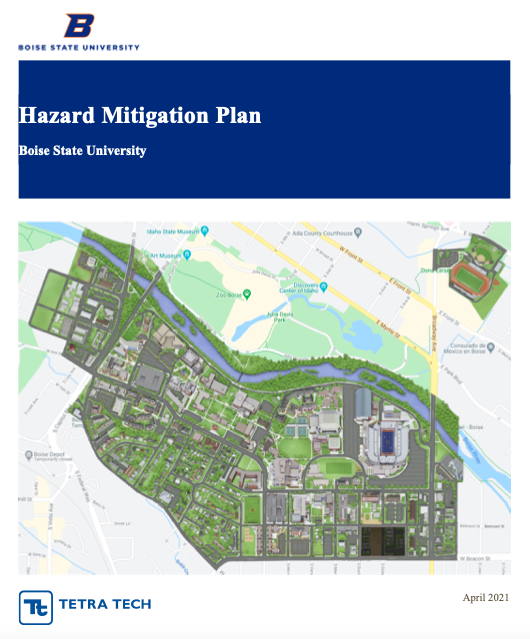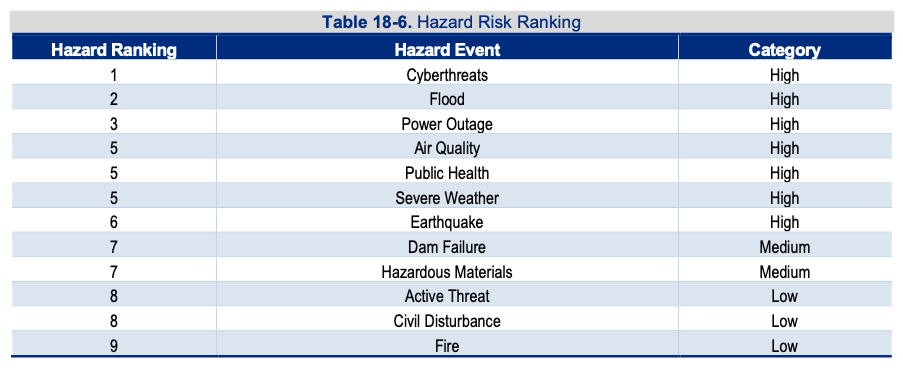In 2021, Boise State University completed its first-ever Hazard Mitigation Plan. We now have an identified list of hazard/threat risks to the campus and an initial Mitigation Strategy for the campus that the Office of Emergency Management, AES, CPF, DPS, and EHSS will use to ensure the campus community and infrastructure is better prepared and resilient for the future.

The plan was submitted to the Idaho Office of Emergency Management and FEMA Region 10 in March 2021. Once reviewed, FEMA Region X approved the plan on April 1, 2021, which now makes over 30 mitigation projects identified in the planning process eligible for funding from the FEMA Building Resilient Infrastructure and Communities (BRIC) mitigation grant program.
Following more than a year and half of research, coordination and planning, the hazard mitigation plan was created to identify cost-effective and sustainable mitigation actions that aim to reduce or eliminate the long-term risk to human life and property from natural hazards and human-caused/technological threats. Our Mitigation Steering Committee was comprised of representatives from every department and division on campus, including several Boise State faculty subject matter experts. We also collaborated with a wide range of community partners that included the National Weather Service, US Army Corps of Engineers, Central District Health, Ada County Emergency Management, City of Boise Emergency Management, and the Idaho Office of Emergency Management.
Ben Wells, Deputy Emergency Manager for the university said having a completed and approved plan is a prerequisite for applying for FEMA mitigation grant projects.
“From the planning efforts, we identified more than 30 potential projects that have been prioritized based on the Hazard Vulnerability/Risk Assessment we accomplished” Wells said. These projects will improve/build upon our existing critical infrastructure, such as adding emergency generators, moving redundant server systems into safer locations on campus, and building our own Green CoGen Power Plant to mitigate the disastrous impact of natural hazards/threats to our campus continuity of operations.”
Over the course of the planning and collaboration, we organized the planning team, reviewed hazards/threats to the Treasure Valley, completed a Hazards Vulnerability Assessment, modeled a variety of hazards, and conducted a Risk Assessment. All of this information was used to create our Mitigation Strategy, which will guide the university in future projects/decisions by providing Mitigation Action Items designed to make our campus a safer place. Plan benefits include identifying our specific vulnerabilities to develop strategies to better protect our campus community and properties. We will also be able to better educate our students, faculty and staff on how we can be more prepared and resilient for potential disasters.
The following natural hazards and human-caused/technological threats were identified as the most probable scenarios with impact to campus continuity of operations:

We also partnered with the Boise State University Hazard and Climate Resilience Institute (HCRI) to survey over 2,000 campus community members (students, faculty and staff) to collect their inputs on potential campus hazards, including a second survey polling COVID-19 impact. This feedback has been incorporated into the plan. The HCRI site has a Local Resources & Hazards page highlighting the natural hazards that can impact the Boise State campus.
If you have any comments or question about the Mitigation Plan, contact the Office of Emergency Management at 208-426-3638 or email eoc@boisestate.edu.
Review the Plan Here: Download Boise State University Hazard Mitigation Plan (PDF) .